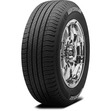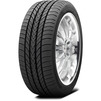Uniform Tire Quality Grade (UTQG) Standards
The National Highway Traffic Safety Administration's Uniform Tire Quality Grade Standards were developed to give consumers with useful information to help them purchase tires based on their treadwear, traction and temperature differences. When looking at UTQG ratings it is important to realize that the Department of Transportation does not conduct the tests. The grades are assigned by the tire manufacturers based on their test results or those conducted by an independent testing company they have hired. The NHTSA has the right to inspect the tire manufacturer's data and can fine them if inconsistencies are found.
1. Treadwear Grades
Treadwear Grades are based on actual street use in which the tire is run in a vehicle convoy along with standardized Course Monitoring Tires. The vehicle runs a prescribed 400 mile loop in West Texas over and over again for a total of 7,200 miles. The car can have its alignment adjusted, air pressure checked and tires rotated every 800 miles. The test tire's and the Monitoring Tire's wear are measured during and at the end of the test. The tire manufacturers then assign a Treadwear Grade based on the wear rates. A grade of 100 would indicate that the tire tread would last as long as the test tire, 200 would indicate the tread would last twice as long, 300 would indicate three times as long, and so forth.
2. Traction Grades
Traction Grades are based on the tire's traction as the tire skids across a specified wet test surface. The UTQG traction test does not evaluate dry braking. The Traction Grade is determined by installing test tires on the axle of a "skid trailer." The skid trailer is pulled behind a truck at 40 mph over wet asphalt and wet concrete test surfaces. Its brakes are momentarily locked and the axle sensors measure the tire's coefficient of friction (braking g forces) as it slides. Since the test evaluates a sliding tire at a constant 40 mph, it places more emphasis on the tire's tread compound and less emphasis on the way the tread was designed. In 1997, the UTQG Traction Grades were updated to provide a new group of AA for the highest performing tires in addition to the earlier A, B and C grades. The grades and their traction coefficients are now the following:
The National Highway Traffic Safety Administration's Uniform Tire Quality Grade Standards were developed to give consumers with useful information to help them purchase tires based on their treadwear, traction and temperature differences. When looking at UTQG ratings it is important to realize that the Department of Transportation does not conduct the tests. The grades are assigned by the tire manufacturers based on their test results or those conducted by an independent testing company they have hired. The NHTSA has the right to inspect the tire manufacturer's data and can fine them if inconsistencies are found.
1. Treadwear Grades
Treadwear Grades are based on actual street use in which the tire is run in a vehicle convoy along with standardized Course Monitoring Tires. The vehicle runs a prescribed 400 mile loop in West Texas over and over again for a total of 7,200 miles. The car can have its alignment adjusted, air pressure checked and tires rotated every 800 miles. The test tire's and the Monitoring Tire's wear are measured during and at the end of the test. The tire manufacturers then assign a Treadwear Grade based on the wear rates. A grade of 100 would indicate that the tire tread would last as long as the test tire, 200 would indicate the tread would last twice as long, 300 would indicate three times as long, and so forth.
2. Traction Grades
Traction Grades are based on the tire's traction as the tire skids across a specified wet test surface. The UTQG traction test does not evaluate dry braking. The Traction Grade is determined by installing test tires on the axle of a "skid trailer." The skid trailer is pulled behind a truck at 40 mph over wet asphalt and wet concrete test surfaces. Its brakes are momentarily locked and the axle sensors measure the tire's coefficient of friction (braking g forces) as it slides. Since the test evaluates a sliding tire at a constant 40 mph, it places more emphasis on the tire's tread compound and less emphasis on the way the tread was designed. In 1997, the UTQG Traction Grades were updated to provide a new group of AA for the highest performing tires in addition to the earlier A, B and C grades. The grades and their traction coefficients are now the following:
|
Traction Grades
AA A B C |
Asphalt g-Force
Above 0.54 Above 0.47 Above 0.38 Less Than 0.38 |
Concrete g-Force
0.41 0.35 0.26 0.26 |
3. Temperature (Resistance) Grades
The UTQG Temperature Grade indicates the extent to which heat is dissipated by a tire. The grade is established by measuring a tire's ability to operate at high speeds by running an inflated test tire against a large diameter high-speed laboratory test wheel.
|
Temperature Grades
A B C |
Speed in mph
Over 115 mph Between 100 and 115 mph Between 85 and 100 mph |
You can find out more information about UTQG standards and tire ratings at www.safercar.gov.
All Season Performance Tires
Excellent response and handling in wet and dry conditions, as well as light snow.
Excellent response and handling in wet and dry conditions, as well as light snow.
Performance Summer Tires
Low profile tires provide great handling and traction for both dry and wet conditions
Low profile tires provide great handling and traction for both dry and wet conditions






